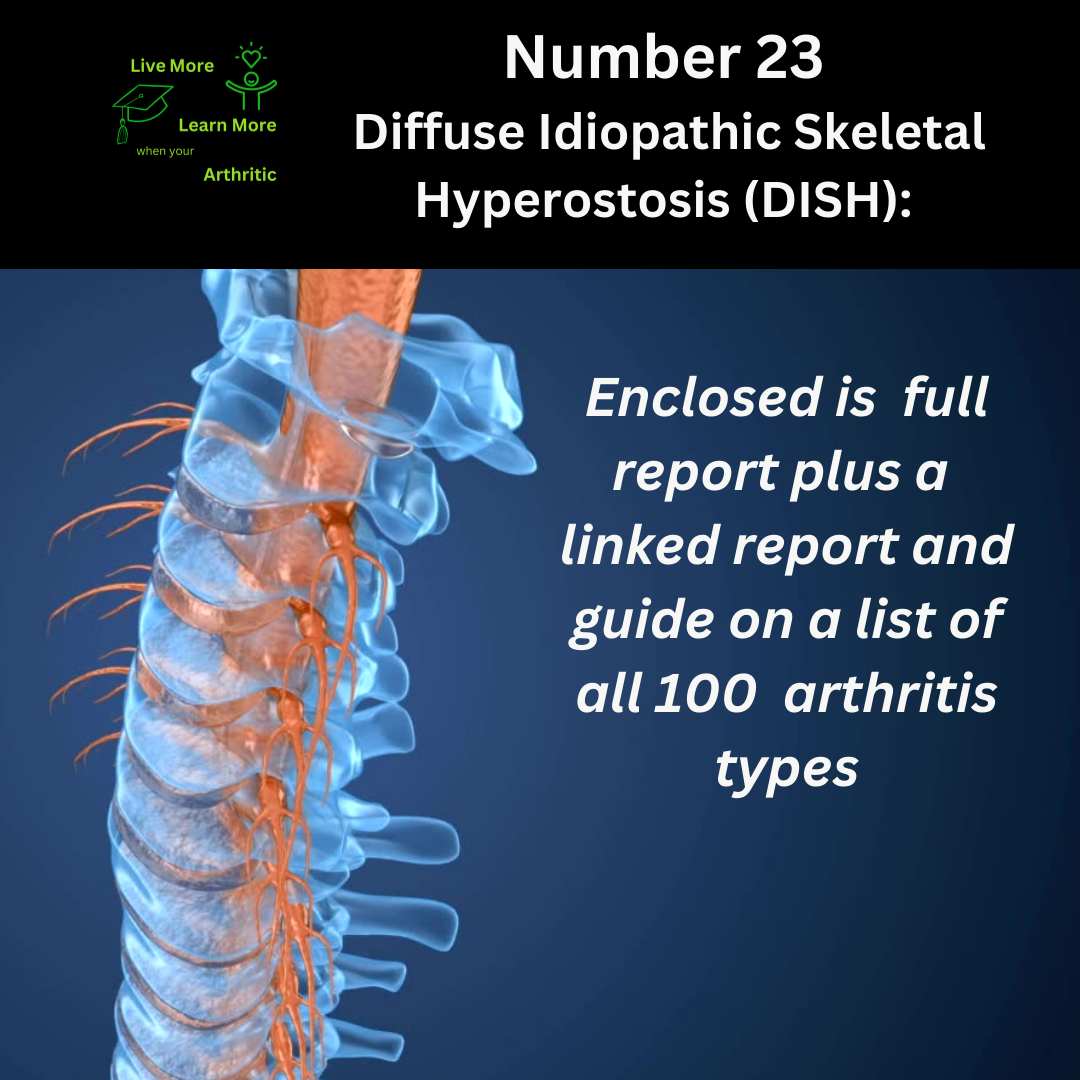
Diffuse Idiopathic Skeletal Hyperostosis (DISH): Number 24 on the list of 100 types of Arthritis
Embracing Life with Diffuse Idiopathic Skeletal Hyperostosis (DISH): A Tale of Resilience
Chapter 1: The Unexpected Journey
Imagine waking up one day to find your body feeling stiff as a board, almost like you’ve turned into a living statue overnight. This is the reality for many individuals living with Diffuse Idiopathic Skeletal Hyperostosis, or DISH for short.
 Chapter 2: Unveiling the Mystery of DISH
Chapter 2: Unveiling the Mystery of DISH
DISH is a unique condition characterized by the abnormal calcification and ossification of ligaments and tendons along the spine and other parts of the body. This excessive growth of bone can lead to stiffness, limited range of motion, and sometimes pain, particularly in the spine, shoulders, elbows, knees, and heels. The affected areas often develop bony outgrowths (osteophytes) that can be visible on X-rays.
Chapter 3: The Mysterious Origins
The precise cause of DISH remains elusive, hence the “idiopathic” part of its name. However, it is more common in older adults, typically over the age of 50. Genetics may also play a role in predisposing certain individuals to develop DISH.
Chapter 4: Navigating the Symptoms
Living with DISH can present a variety of symptoms beyond physical stiffness. Imagine trying to tie your shoelaces or reach for a high shelf with limited mobility in your spine and joints. Everyday tasks become challenges, but with creativity and determination, many individuals find ways to adapt.
Chapter 5: Grasping the Impact
While DISH itself is not directly life-threatening, its impact on quality of life can be significant. The condition can affect one’s ability to participate in activities, leading to frustration and limitations. However, resilience and a positive outlook can make all the difference.
Chapter 6: Proactive Steps for Quality of Life
Despite its challenges, a proactive approach can greatly enhance quality of life for those with DISH. Regular low-impact exercises like swimming or gentle stretching can help maintain flexibility and prevent further stiffness. A balanced diet rich in anti-inflammatory foods can also support overall health and joint function.
Chapter 7: Complications and Concerns
While DISH itself does not typically lead to complications like joint destruction seen in other arthritic conditions, it can predispose individuals to other health issues. For example, those with DISH may be at a higher risk of developing cardiovascular disease or experiencing difficulties with swallowing due to spinal changes.
Chapter 8: Holistic Pursuits and Health Discoveries
In the quest for improved well-being, some individuals with DISH explore holistic approaches. Practices like yoga, acupuncture, or herbal supplements are sometimes incorporated into their wellness routines to manage symptoms and promote relaxation.
 Chapter 9: Demystifying Demographics
Chapter 9: Demystifying Demographics
DISH primarily affects older adults, with the average age of onset typically being over 50. While the condition can occur in both men and women, it appears to be slightly more prevalent in men.
Chapter 10: Connections and Considerations
Interestingly, individuals with DISH may also be at higher risk for certain interconnected conditions, such as metabolic syndrome or type 2 diabetes. This underscores the importance of comprehensive health management and regular check-ups.
Chapter 11: Embracing Resilience
Living with DISH requires resilience, creativity, and a touch of humor. Despite its challenges, many individuals find ways to adapt, pursue their passions, and embrace life to the fullest. The journey may be unexpected, but with the right mindset and support, every day can be a triumph.